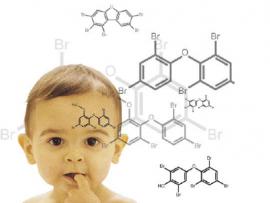Among poisoning by toxic substances: cardiovascular drugs, tranquilizers and antipsychotics, sedatives and hypnotics, barbituric acid derivatives, poisoning agricultural, industrial and plant poisons, household chemicals, alcohol, petroleum products, heavy metal salts.
Among older children occupy a significant place deliberate poisoning by alcohol and drugs, the response simulation. One reason for the poisoning of schoolchildren are suicidal and parasuicidal installation.
Acute poisoning in children always requires emergency medical care. The outcome of the disease and the effectiveness of treatment of toxicological patients largely depend on the timely started therapy, its volume and strong continuity at various stages of the application of detoxification and symptomatic therapy.
The following signs may indicate on a poisoning with poison:
- characteristic odor at poisoning with kerosene, gasoline, alcohol, acetone, dichloroethane;
- burns to the skin and mucous membranes of the mouth in case of poisoning acids, alkalis, quicklime, potassium permanganate, iodine;
- cyanosis in case of poisoning with aniline, nitrobenzene, nitrate, sodium nitrite;
- cutaneous petechial hemorrhages in case of poisoning heparin fenilinom, benzene, xylene, salicylates;
- hematuria at a poisoning with acetic acid, potassium chlorate salt, iodine, salicylates;
- cramps at a poisoning with an adrenaline, hydrochloride, chlorpromazine, their analogues, analgin, butadionom, cardiac glycosides, strychnine nitrate;
- wide pupils at a poisoning atropine sulphate, bleached, belladonna, trioksazina;
- narrow pupils in cases of poisoning chlorpromazine, barbiturates, pilocarpine, codeine;
- sweating in cases of poisoning by salicylates, pilocarpine;
- increase in body temperature in cases of poisoning with antibiotics, salicylates, sulfonamides, atropine sulfate, haloperidol;
- change the color of the mucous membranes at poisoning by a paints, potassium permanganate, iodine, salts of heavy metals;
- bronhoreya, hypersalivation in cases of poisoning of the WCF;
- flushing of the skin in cases of poisoning Rauwolfia's derivatives;
- dryness of mucous membranes and skin in cases of poisoning atropine sulfate;
- abdominal pain in cases of poisoning by organophosphorus compounds, salts of heavy metals, cauterizing poisons;
- color change of bowel movements in cases of poisoning with heavy metal salts, FOS;
- catatonic stupor in cases of poisoning with a frenolona, trifluoperazine, haloperidol.
Acute poisoning: Symptoms
The poison and toxins get in an organism in different ways, it may be entering with drug injection through the outer ear canal, mouth, or rectum, through the skin with bites of snakes or insects. Acute poisoning arise both from single exposure of pathogenic factors, well as after re. At long application is developing a chronic form.
In addition, much depends on the dose, duration of action and the kind of damaging agent. Some poisons have an expressed neurotoxic effects, which is expressed in disturbance of mental and physical activity, convulsions, paralysis and coma. Other toxins is cardiotoxic and pulmonological, and lead to a violation of rhythm and conduction of the heart, myocardial dystrophy and edema of respiratory organs with a gasp. A third kinds - hepato- and nephrotoxic, damage the liver and kidneys.
Acute poisoning have the following symptoms: lacrimation, irritation of the external mucous membranes, skin itching, and redness of the skin, nausea, vomiting, and abdominal colic, diarrhea, fever, chills, hypotension, and many other features.
In the acute phase of poisoning in children can identify several major non-specific syndrome, appearance of which characterizes the general the phenomenon of exogenous intoxication and allows you to determine severity of the poisoning. They include neuropsychiatric syndrome, respiratory failure, syndrome disorder of hemodynamics, syndrome dysfunction of the digestive system.
These details may prove crucial for the adoption of emergency measures and the subsequent excretion of poisons and toxins from the body of the victim. Therapeutic measures in acute poisoning is usually directed at the elimination of toxic hearth, relief of life-threatening symptoms, as well as on the prevention the possible consequences and complications of acute poisoning. In most episodes acute poisoning require hospitalization.
Diagnosis and treatment
Before emergency aid in case of poisoning, it is necessary to find out the cause of the adverse condition, in particular the type and kind of poison, the way of contact with skin or inside the body, the start time of the first symptoms, the duration of exposure, as well as the number and concentration of pathogenic agents.
After diagnosis is performed general prescription and in addition to them symptomatic treatment of severe group of patients, observing the principles of syndromic correction.
Risk assessment danger of toxic substances for the child is one of the important tasks that allow correctly to predict the development of the pathological process, its intensity and depth of destruction of the internal organs and systems, and this determines the timely treatment.
In the context of non-specialized department for the diagnosis of common clinical manifestations of intoxication, evaluation of the severity poisoning, is offered the complex of biochemical and functional methods of examination.
To assess the local destruction are used instrumental methods: laryngoscopy oropharynx and the glottis; esophagogastroscopy esophagus and stomach; sigmoidoscopy of the rectum; cystoscopy of the bladder wall in the case of mistaken administration of poisons cauterants.
Specialized care is carried out in a hospital in the department of toxicology and intensive therapy and reanimation.
Chelation Therapy consists of 3 main areas: detoxification, symptomatic and pathogenetic. Complex of detoxification methods consists of 3 groups.
- Conservative methods of removing poisons: Gastric lavage, dialysis and forced diuresis, removing poison from the skin and mucous membranes, conjunctiva.
- Methods for intensive detoxification: antidote therapy, exchange transfusion, peritoneal dialysis, hemodialysis, hemosorption, hyperbaric oxygenation.
- Resuscitation detoxification methods: ex sanguine delucia, in conjunction with replacement of one blood volume, the use of correctors and antidotes. These techniques are used in severe and terminal group of patients.
In the specialized department the patients are whole acute intoxication period and the period of complications requiring intensive corrective and supportive therapies. Children who have suffered from poisoning are subject to the active dispensary observation after discharge from hospital.
hide
 Pediatric Medical Toxicology is the study of toxic effects of chemicals on infants, children and adolescents.
Pediatric Medical Toxicology is the study of toxic effects of chemicals on infants, children and adolescents. 






